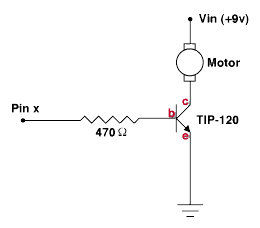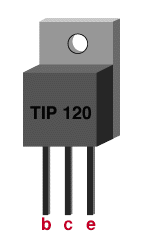
Click on the hyperlink for answers which are too long to fit in this document.
How do you solder?
See the soldering tutorial located elsewhere on this web site.
How can I make my electronics look neat?
If you have just a few components, mount them on the Stamp board. Bend their leads and push through the holes on the right side of the board until the component lies flush against the board. Wrapping on the back side will hold things in place. Trim the leads if too long.
For more components, try mounting on a piece of corregated cardboard. Just push the leads right through and wrap on the back side. For a more professional look, mount your components on a predrilled breadboard such as Radio Shack 276-150 or Jameco 43140.
What if I don't know anything about
programming?
This project requires only a minimal level of programming skills. You can learn a great deal about programming by studying the example programs given in the Application Notes in the Stamp manual. Also, study the examples provided in class. See the PBASIC Programming Tutorial elsewhere on this web site. Finally, ask lots of questions of the course instructors and your fellow classmates.
Can I do any computer graphics or have a numeric display?
No, the Stamp has no display and no keyboard. You can build a simple display and keyboard, but for this you need advanced electronics skills.
When should I start my project?
Working to a deadline that is far away is extremely difficult. This is a project where you are bound to fail if you only leave yourself a week in which to do all the work. Recommendation: (1) Start one month before the due date. (2) Finish developing and detailing your concept three weeks before due date. (3) Take two weeks to construct your project. (4) This leaves you one week for test and refinement.
How much can a motor lift? How fast can it spin?
It all depends on everything. A good rule of thumb is that a motor can lift the weight of the battery that drives it; or that a motor can lift its own weight. Remember that motors can either spin slow and be strong (near stall), or can spin fast and be weak (at no load). You can't have both. Motors will spin faster and be stronger the higher the battery voltage. A good test of whether you are driving a motor too hard is to feel it. If it is hot, turn down the voltage or reduce the load. Also, many motors will wear out their bearings if run for more than a few seconds at their no load speed.
Gearmotors have a built in gear train transmission. This means the shaft will spin much more slowly at no load conditions with considerable output torque. Consider gearmotors if you have a vehicle for which you want to attach the wheels directly to the motor shaft.
In all cases, test your motor in a mockup of the intended load conditions and using the intended battery before you get too far along into a machine concept. You could well find out that the motor you have will not perform its intended task. In this case, you have to change your motor, your task or both.
Where is +5V and ground on the Stamp board?
The markings on the Stamp board I/O pins are a little confusing. Hold the board with the words "BASIC Stamp" at the top and "PARALLAX" at the bottom. Now look at the I/O pins. The top pin marked "Vin" is the plus side of the 9V battery. The next two pins are +5 volts. The next eight pins are the eight I/O ports; for these the labels line up. The bottom three pins are all ground and it doesn't matter which you connect to.
What kind of wire should I use?
You can use your 30g wrap wire for just about everything in your project. The only exceptions are anything which draws more than 2 amps of current (such as large motors or lamps).
Normally, 30g wire would be restricted to logic and control signals with 22 or 24g wire for the rest, but for the "informal" circuits you are building, it is acceptable to stick with the 30g.
What if I don't know anything about
electronics?
Read the Radio Shack book titled "Getting Started in Electronics", (RS part number 62-5003, approximately $5.00). Great book, you can't get more basic than this. For a more comprehensive approach try "The Art of Electronics" by Horowitz and Hill, available at the bookstore, or by special order. Expensive, but one of the best all-around books on practical electronics.
How can I make my motor go in both directions?
To run you motor in two directions, you need a double-pole, double-throw (DPDT) relay for direction control and another relay or transisitor for on-off control. A schematic for how to hook everything up will be (was) passed out in class.
Where can I get stuff for my project?
For all kinds of goodies, try Ax-Man Surplus. It has all kinds of motors and lots of "junk" which you might be able to cannibalize, all at very reasonable prices. Bring along a 9 V battery and two pieces of wire so you can try out the motors. Three locations: (1) 1639 Univ. Av., St. Paul (646-8653); (2) 1071 E. Moore Lake Dr., Fridley (572-3730); (3) 9801 James Circle, Bloomington (884-2668). Call for hours.
For electronics, try AEI Electronics, located at 224 Washington Av. N in downtown Minneapolis (tel: 338-7149, open 7-5:30 M-F, 9-1 Sat). Excellent stock of electronics parts (including many of the items you see in your Jameco catalog) and reasonable prices. Or, try any Radio Shack. See the Yellow Pages for area locations. Or, mail order from Jameco. If you do order from Jameco, be aware they have a $25 minimum and that fast (one or two day) delivery will add an extra charge.
For fasteners and hardware, go to any hardware store. For ideas, wander the aisles of Menards, Target or any decent hardware store. Seven Corners Hardware in St. Paul is particularly recommended.
How big a program will fit into my Stamp?
It depends on which instructions you use. The Stamp has 256 bytes of program memory, but each instruction takes 1-4 bytes of that memory. For ordinary programs, don't expect to fit more than 75 lines of code. Note that the program is stored on the EEPROM chip while variables are stored right on the microprocessor chip so no matter how big your program is you won't overwrite your variable space. (Warning, this answer has not been tested. If you find a different answer, let us know.)
How long will my Stamp run on a fresh 9v battery?
It depends on what the Stamp is doing. In sleep mode, it can run for weeks. If you are turning LED's or transistor switches on for long periods, the battery might run down in an hour or two. If you try to run a motor off the same battery which powers your Stamp, that battery will run down quickly.
How can I power motors or other external components which take
more than a few milliamps of current?
Use a separate battery to control motors. Can be 6, 9 or 12 volts; match to your motor. Remember, you must connect the battery ground (the - terminal) of the extra battery to the ground of your Stamp circuit (very important).
Since your Stamp is not able to provide sufficient current to run the device directly, you must use a relay or a transistor controlled by the Stamp to turn high current devices on and off. A relay is basically a magnetically controlled on-off switch. When you apply current to a solenoid in the relay, a small mechanical switch is thrown, and a connection is made. (A relay click is what you hear when you start your car. It is usually masked by the sound of the engine starting. When your battery doesn't have enough power to turn over the car, all you hear is the click of the contacts of the relay touching.)
A transistor is basically an electronic relay. For controlling motors, we recommend you use a TIP120 NPN power transistor. Here is a schematic for controlling a motor:

Note: use a 1K resistor to control the base, rather than the 470 ohm shown above.
When you set pin x high, current flows through the 1 Kohm resistor and into the base of the transistor (labeled b). When current flows from the base to the emitter, the electronic "switch" is closed, current flows from collector to emitter (labelled c and e on the diagram), and the motor runs. Using a TIP120, the motor can draw up to 2 Amps of current from the battery (any more and the transistor gets too hot), but the transistor itself will only draw about 11 milliamps from the Stamp.
In real life, a transistor (TIP 120) looks like this:

When facing the front of the transistor, the pins are (from left to right), the base, collector, and emitter.
How much current can the Stamp provide?
The Stamp can provide 20 mamps per I/O pin, but only 40 mamps total for the chip. This means you can have 3-4 LED's on at the same time, or you can turn on 2-3 motors via a power transistor.
How do I attach wires to my Stamp board?
No soldering or gluing or taping wires to the Stamp board. Instead, wire-wrap to the Stamp pins.
How many things can I connect to my Stamp?
The Stamp board has eight I/O pins (numbered 0-7). Any can be an input
and any can be an output. Three of the pins are reserved: one to
receive the trigger signal, one to send the trigger signal and one for
a watchdog LED. That leaves five pins to connect to other devices. We
recommend that you have as few things connect to the Stamp as you can
get away with and still make your concept work. The more things you
have connected, the harder it will be to build, test and debug.